JKBOSE 9th Class Science Solutions Chapter 12 Tissues
JKBOSE 9th Class Science Solutions Chapter 12 Tissues
JKBOSE 9th Class Science Solutions Chapter 12 Tissues
Jammu & Kashmir State Board JKBOSE 9th Class Science Solutions
J&K class 9th Science Tissues Textbook Questions and Answers
BASIS AND BASICS
◆ Cell is the structural and functional unit of life, while the group of cells coordinating to perform a specific function is called tissue.
◆ Scientific study of tissues is called histology.
◆ Cluster of cells, called a tissue is arranged and designed so as to give highest possible efficiency as tissues have provided division of labour in multicellular organisms.
◆ Due to improved organisation, higher efficiency, multicellular organisms have higher survival value.
PLANT TISSUES
◆ Most of plant cells are dead which provide mechanical strength and need less maintenance.
◆ In plants there are some tissues which continue dividing.
◆ On the basis of power of division of cells, plant tissues are of two types: Meristematic tissues and permanent tissues.
Classification of Plant Tissues
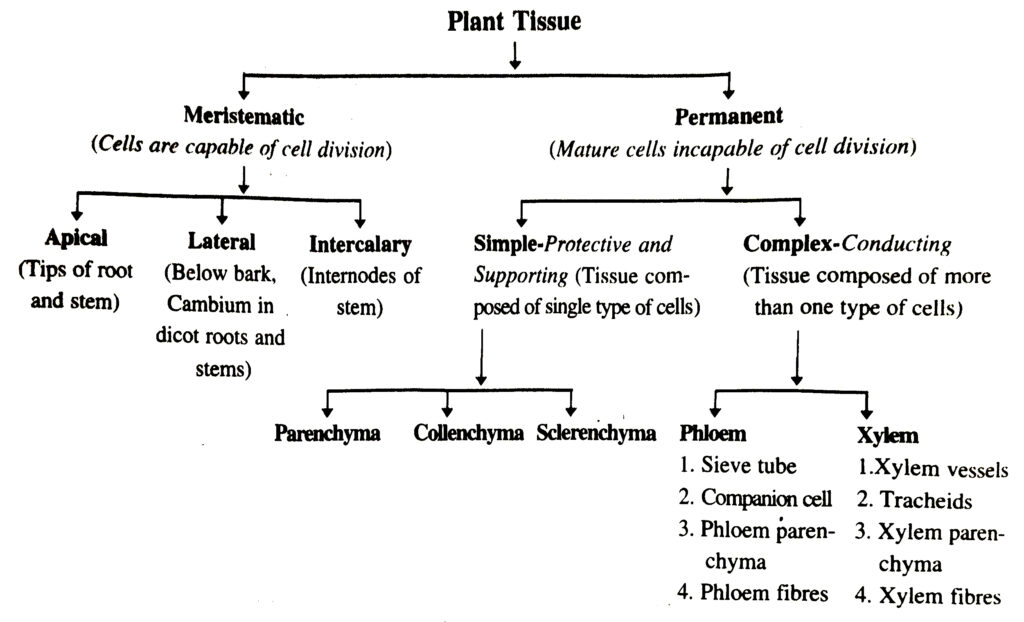
◆ Meristematic tissue has power of division throughout life, so helps in growth plant but in some specific regions.
◆ Simple Permanent tissue has lost the division power and is of three types :
Parenchyma, Collenchyma and Sclerenchyma.
◆ Parenchymal tissue is formed of thin walled, living, oval cells having walls formed of only cellulose. It forms cortex, endodermis, pericycle, pith etc. of different parts of plants. It is loosely packed with intercellular spaces. It is modified to form epidermis covering of all the parts of plant body, chlorenchyma for photosynthesis, aerenchyma for floating in the hydrophytes.
◆ Collenchyma is formed of thick walled (with pectinised cell wall) and living cells and is found in hypodermis of dicot stem. It provides flexibility to plants.
◆ Sclerenchyma is formed of thick walled (with lignified cell wall) and dead cells and forms hypodermis of monocot stem, bark, shells of nuts, etc. It makes the plants hard and stiff. It provides strength to plant parts. It also forms hard covering of seeds and nuts.
◆ Protective tissues include epidermis (single layer of cutinized parenchymal cells covering all the aerial parts of plant body. It prevents evaporation of water) and cork (many layers of suberinised dead cells covering the old stem and roots. It helps in conservation of water and formation of insulation boards). Epidermis protects plants from mechanical injury, and attack by parasitic fungi.
◆ Stomata are microscopic apertures mainly present on the lower surface of leaves and help in exchange of gases during respiration and photosynthesis. Transpiration occurs through stomata.
◆ Compound permanent tissue includes xylem and phloem.
◆ Xylem is formed of 4 types of cells : Tracheids, tracheae (vessels), xylem fibres and xylem parenchyma (only living cells of xylem).
◆ Phloem is also formed of 4 types of cells: Sieve tube cells, companion cells, phloem fibres and phloem parenchyma (only living cells in phloem). Phloem helps in conduction of food within the plant body.
ANIMAL TISSUES
◆ On the basis of their functions, animal tissues are of four types: Epithelial, muscular, connective and nervous tissue.
Animal Tissues

◆ Epithelial tissue is covering and protective tissue and is formed of one or more layers of compactly arranged cells with no intercellular spaces and resting on basement membrane.
◆ Muscular tissue is formed of highly elongated and useful secretions contractile cells called muscle fibres and is with properties of excitability and contractability. It helps in movements of body parts and locomotion.
◆ Muscular tissue is of three types :
(a) Striated or skeletal muscular tissue
(b) Visceral or smooth or unstriated muscular tissue
(c) Cardiac muscular tissue.
(a) Striated muscle fibres. The striated muscles are also known as voluntary, striped or skeletal muscles since their contraction is under the control of the will and the entire muscle fibre shows alternate dark and light bands. The striated muscle fibres are long cylindrical unbranched cells, with a number of nuclei.
Longitudinal myofibrils, embedded in the cytoplasm called sarcoplasm are the contractile elements.
Striated muscles have powerful and rapid contractions which are voluntary. These muscles can get tired and need rest.
Location. Muscles of the limbs, body wall, face, neck, tongue, etc.
Functions. Movements of body and body parts.
(b) Unstriated muscle fibres. These muscle fibres are also called as smooth or visceral muscle fibres as they do not show striations. They consist of long spindle-shaped, unbranched cells. They are uninucleate. Nucleus is oval in shape and lies in the centre. They are smooth as dark and light bands are absent. The muscles are involuntary in their action as they are not under the control of botendit central nervous system. They do not get fatigued.
Location. Unstriated muscle fibres occur as sheets and are found in walls of the alimentary canal and internal organs, ducts of glands, urinogenital ducts and blood vessels.
Function. Unstriated muscles cause slow and prolonged contractions which are involuntary. Movement of food in alimentary canal, blood in blood vessels, urine in ureters.
(c) Cardiac muscle fibres. The wall of heart is formed of cardiac muscles. The fibres are 14 mm in diameter and are of varying length. Each fibre has side branches of neighbouring cells. The cardiac muscle fibre has a barrel-shaped nucleus in the centre of cell. The myofibrils are present which bear dark and light bands. The cardiac muscles are involuntary in action and highly vascular and contract quickly and automatically. They have their own wave of excitation. The two successive cells have a disc called intercalated disc between them which acts as a booster for wave of muscle contraction.
Location. Wall of heart.
Function. Rhythmic contraction and relaxation of heart (Heart beat).
◆ Connective tissue mainly acts as binding tissue and has large amount of matrix.
◆ Connective tissue is of three types: Connective tissue proper, Skeletal connective tissue and vascular connective tissue.
◆ Connective tissue proper. Areolar connective tissue Has soft matrix. White fibrous connective tissue (with large number of bundles of white fibres and forms tendons and protective sheaths); Yellow fibrous connective tissue (with many elastic fibres and forms ligaments); Adipose connective tissue (with large number of fat-storing adipocytes e.g. below the skin of mammals, fat-bodies of frog, etc.)
◆ Skeletal connective tissue has dense and mineralised matrix and forms endoskeleton of vertebrates. It includes cartilages and bones.
◆ Cartilage is formed of oval-shaped widely spaced-solid matrix formed of proteins and sugars chondroblasts present in groups of 2 or 4 in a glycoproteinaceous matrix and is solid and non-vascular.
◆ Bone is hardest tissue and is generally with a marrow cavity at centre having haemopoietic tissue, bone marrow.
◆ Vascular connective tissue has fluidy and fibre-free matrix. It is of two types : Blood and Lymph.
◆ Blood is red vascular connective tissue and flows inside the blood vessels. It is slightly alkaline and purple or bright red coloured. It is formed of plasma and blood corpuscles which are of three types: Erythrocytes or RBCs mainly with haemoglobin. These help in transportation of O₂ and CO₂, Leucocytes or WBCs (rounded or amoeboid and nucleated corpuscles and Blood platelets (cytoplasmic fragments and help in blood clotting at the injury).
◆ Lymph is white vascular connective tissue and flows inside the lymph-vessels. It is formed of plasma and leucocytes so is called filtered blood. It acts as middle man between body cells and blood.
◆ Nervous tissue has the properties of excitability and conductivity of nerve impulses.
◆ Neurons are structural and functional units of nervous tissue. Neurons receive and conduct impulses.
◆ Each neuron is formed of a nucleated cyton and one or more nerve processes which are of 2 types : Axon or efferent and dendron or afferent.
◆ When axon (acts as neuraxis) is surrounded by one or more sheath, then it is called nerve fibre.
◆ Nerve fibres are of two types : Medullated nerve fibres and Non-medullated nerve fibres.
IMPORTANT TERMS/FACTS TO MEMORISE
⇒ Muscle fibres have unique properties of excitability and contractability.
⇒ Neuron is the structural and functional unit of nervous system.
⇒ Nerve cells (Neurons) have unique properties of excitability and contractability.
⇒ Tissues. provide protection, mechanical strength and increases functional efficiency.
⇒ Growth of plants occurs in certain specific regions.
⇒ The muscles of heart show rhythmic contraction and relaxation throughout life.
⇒The functional combination of nerve and muscle tissue is fundamental to most animals.
⇒ This combination enables the animals to move rapidly in response to stimuli.
⇒ Tissue. A group of similar or dissimilar cells alongwith intercellular substance coordinating to perform a specific function. Blood, phloem and muscles are examples of tissues.
⇒ Histology. Microscopic study of tissues.
⇒ Meristem. A group of cells capable of dividing to form new cells.
⇒ Xylem. A compound tissue formed of tracheids, vessels, parenchyma and fibres, and helps in conduction of water and minerals in the plants.
⇒ Phloem. A compound tissue formed of sieve tube cells, companion cells, parenchyma and fibres, and helps in conduction of food in the plants.
⇒ Epithelial tissue. An animal covering and protective tissue.
⇒ Sarcolemma. Surface covering of striated muscle fibres. Sarcoplasm. Cytoplasm of a muscle fibre.
⇒ Sarcomere. A structural and functional unit of a muscle fibre.
⇒ Tendon. A band of white fibres surrounded by connective tissue sheath which joins muscles to bone.
⇒ Ligament. A band of yellow fibres surrounded by connective tissue sheath which joins bone to bone.
⇒ Cartilage. An elastic skeletal tissue and acts as shock absorber.
⇒ Bone marrow. A haemopoietic tissue inside the marrow cavity of the bones.
⇒ Osteoblasts and Osteocytes. They are bone forming and bone cells respectively.
⇒ Blood platelets. Blood corpuscles which help in blood clotting at an injury.
⇒ Axon. An efferent nerve process of a neuron.
TEXTBOOK QUESTIONS (SOLVED)
Q. 1. What is a tissue ?
Ans.— Tissue. A group of cells that are similar in structure and/or work together a particular function is called tissue.
Q. 2. What is utility of tissues in multicellular organisms ?
Ans.— 1. They provide protection and mechanical strength.
2. Tissues provide highest possible efficiency of function.
Q. 3. Name types of simple tissues.
Ans.— Types of simple tissues.
1. Parenchyma
2. Collenchyma
3. Sclerenchyma.
Q. 4. Where is apical meristem found ?
Ans.— Apical meristem is present at the growing tips of stems and roots of plants.
Q. 5. Which tissue makes up the husk of coconut ?
Ans.— Sclerenchyma tissue.
Q. 6. What are constituents of phloem ?
Ans.— Four types of elements :
1. Sieve tubes
2. Companion cells
3. Phloem fibres
4. Phloem parenchyma.
Q. 7. Name the tissue responsible for the movement of our body.
Ans.— Muscular tissue.
Q. 8. What does a neuron look like ?
Ans.— A neuron consists of cell body cyton with hair-like parts called dendrites and long axon. Thus gives the appearance of miniature tree.
Q. 9. Give three features of cardiac muscles.
Ans.— 1. Heart muscles are cylindrical, branched and uninucleate
2. They are involuntary and undergo rhythmic contraction and relaxation.
3. Intercalated discs are present at the junction of two cells.
Q. 10. What are functions of areolar tissue ?
Ans.— Areolar tissue fills space inside the organ, support internal organs and help repairs of the tissues.
TEXTBOOK EXERCISES (SOLVED)
Q. 1. Define the term ’tissue’.
Ans.— Refer to Q. No. 1 TBQ .
Q. 2. How many types of elements together make xylem tissue ? Name them.
Ans.— Four types of elements make xylem tissue. They are:
1. Tracheids
2. Vessels
3. Xylem parenchyma
4. Xylem fibres.
Q. 3. How are simple tissues different from complex tissues in plants ?
Ans.— Differences between simple tissue and complex tissue in plants.
| Simple tissue | Complex tissue |
| 1. Similar types of cells which have common origin and function. | 1. A group of more than one types of cells having common origin and working together as a unit. |
| 2. All cells are similar in origin and structure. | 2. The cells have different origin and structure. |
| 3. Parenchyma, Collenchyma and Sclerenchyma are the three types. | 3. Xylem and phloem are the two main types. |
Q.4. Differentiate between parenchyma, collenchyma and sclerenchyma on the basis of their cell wall.
Ans.—
| Feature | Parenchyma | Collenchyma | Sclerenchyma |
| Cell wall | Thin walls | Thickened cell
wall at corners |
Thickened walls due
to lignin. |
Q. 5. What are functions of stomata ?
Ans.— Functions of stomata.
1. They are necessary for exchanging, gases with the atmosphere.
2. Transpiration also takes place through stomata.
Q. 6. Diagramatically show the differences between three types of muscle flores
Ans.— Three Types of Muscle Fibres.

Q. 7. What is specific function of cardiac muscles ?
Ans.— Cardiac muscles undergo rhythmic contraction and relaxation. It is responsible for heart beat and thus plays a role in circulation (pumping) of blood in the body.
Q. 8. Differentiate between striated, unstriated and cardiac muscles on the basis of their structure and site/location in the body.
Or
Write two features of cardiac muscles.
Or
Give two features of cardiac muscles.
Ans.— Differences between Striated, Non-Striated and Cardiac Muscle Fibres
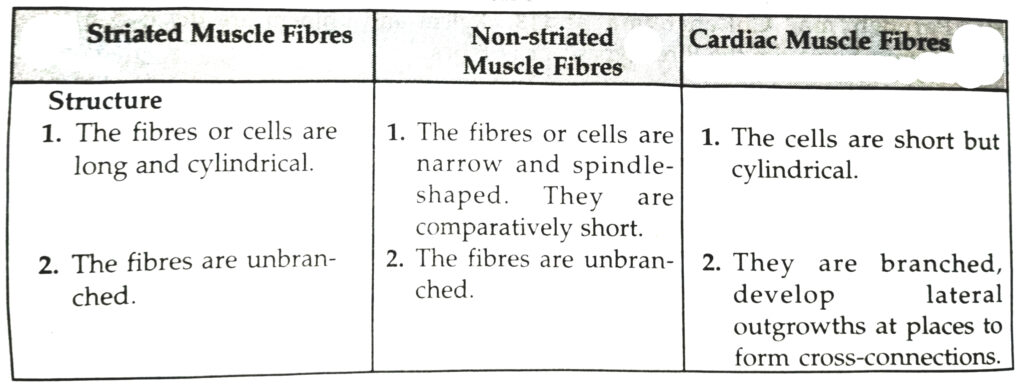

Q. 9. Draw a labelled diagram of a neutron.
Ans.— Structure of neuron

Q.10. Name the following :
(a) Tissue that forms inner lining of our mouth.
(b) Tissue that connects muscle to bone in humans.
(c) Tissue that transports food in plants.
(d) Tissue that stores fat in our body.
(e) Connective tissue with a fluid matrix.
(f) Tissue present in the brain.
Ans— (a) Squamous epithelium
(b) Tendon
(c) Phloem
(d) Adipose tissue
(e) Blood (Vascular tissue)
(f) Nervous tissue.
Q.11. Identify the type of tissue in the following: skin, bark of tree, bone, lining of kidney tabule, vascular bundle.
Ans.— 1. Skin — Epithelium and connective tissues
2. Bark of tree — Secondary epidermis
3. Bone — Connective tissue
4. Lining of kidney tubule — Cuboidal epithelium
5. Vascular bundle — Xylem and phloem (Conducting tissue).
Q.12. Name the regions in which parenchyma tissue is present.
Ans.— Pith and cortex of stem and root.
Q. 13. What is the role of epidermis in plants ?
Ans.— Role of epidermis
1 Protection of all parts of a plant.
2. Secretion of waxy-water resistant layer on their outer surface.
3. Epidermis aids in protection against loss of water, mechanical injury and invasion by parasitic fungi.
Q. 14. How does cork act as a protective tissue ?
Ans.— Cell of cork are dead and compactly arranged without intercellular spaces. They have a chemical called suberin in their walls that makes them impervious to gases and water. This cork acts as a protective tissue.
Q. 15. Complete the table:

Ans.— 1. Parenchyma
2. Sclerenchyma
3. Phloem.
ADDITIONAL IMPORTANT QUESTIONS
LONG ANSWER TYPE QUESTIONS
Q. 1. Define tissue. Differentiate meristematic and permanent tissue. Describe different types of primary meristematic tissue.
Ans.— Tissue. A tissue is a group of similar or dissimilar cells coordinating to perform a specific function.
| Meristematic tissue | Permanent tissue |
| 1. Cells are thin walled, living, oval or rounded, and isodiametric. | 1. Cell are thin or thick walled, living, or dead, oval or rounded or elongated fiber – like. |
| 2. Divide throughout life so help in growth. | 2. Lost the division power power, so do not help in growth. |
| 3. Reserve food is absent. | 3. May be present. |
| 4. Vacuoles are absent. | 4. Vacuoles are present. |
Types of primary meristematic tissues. On the basis of their position, these are of three types:
(i) Apical meristem lies at shoot and root apices and helps in longitudinal growth.
(ii) Intercalary meristem lies between shoot and root apices and helps in longitudinal growth.
(iii) Lateral meristem lies on lateral sides of stem and root and helps in increase in diameter.

Q. 2. Differentiate between parenchyma, collenchyma and sclerenchyma.
Ans.— Differences between parenchyma, collenchyma and sclerenchyma.

Q. 3. What is xylem ? Name the different types of elements of xylem and give their function.
Ans.— Xylem, also called wood, is compound tissue of the plants which primarily helps in conduction of water and minerals from the root system to various parts of shoot system (Ascent of sap).
| Xylem elements | Function |
| 1. Tracheids | Long distance conduction of water and minerals. |
| 2. Tracheae or vessels | Upward from the root system to various parts of shoot system. |
| 3. Xylem parenchyma | Storage and short distance conduction of water and minerals. |
| 4. Xylem sclerenchyma | Mechanical support so helps in resisting strong winds. |
Q. 4. Define phloem. Name types of elements found in the phloem and give their function.
Ans.— Phloem, also called bast, is a compound tissue which helps in downward conduction of food.
| Phloem elements | Function |
| 1. Sieve tube cells | Long distance conduction of food from the leaves to other parts of plant body. |
| 2. Companion cells | Control the functioning of dead sieve tube cells. |
| 3. Phloem parenchyma | Storage and short distance conduction of food. |
| 4. Phloem sclerenchyma | Mechanical support. |
Q. 5. Draw labelled diagrams showing various kinds of elements of xylem.
Ans.— Elements of xylem.
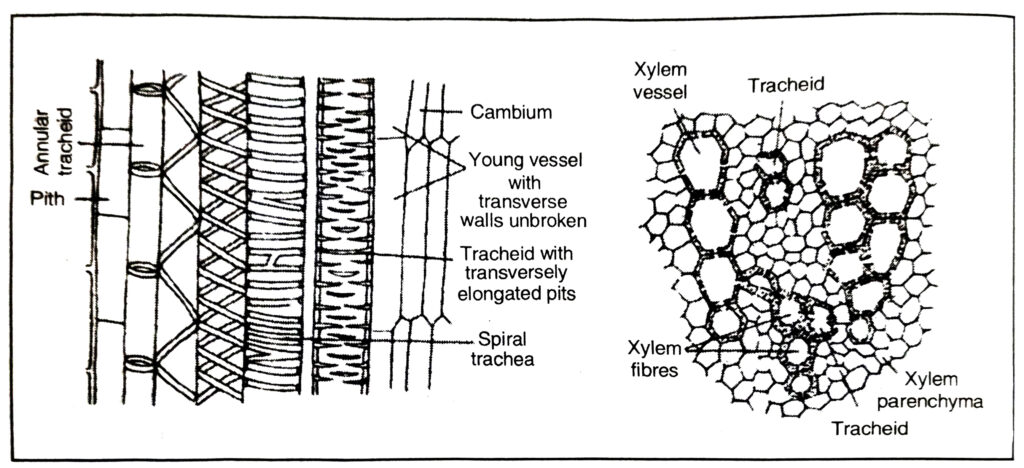
Q. 6. Sketch the elements of phloem.
Ans.—

Q.7, Give an account of types of epithelia.
Ans.— Simple epithelium is unilaminar in which cells are arranged in only one layer. It is found in those parts of body where wear and tear are less. Types of simple epithelial tissues are :
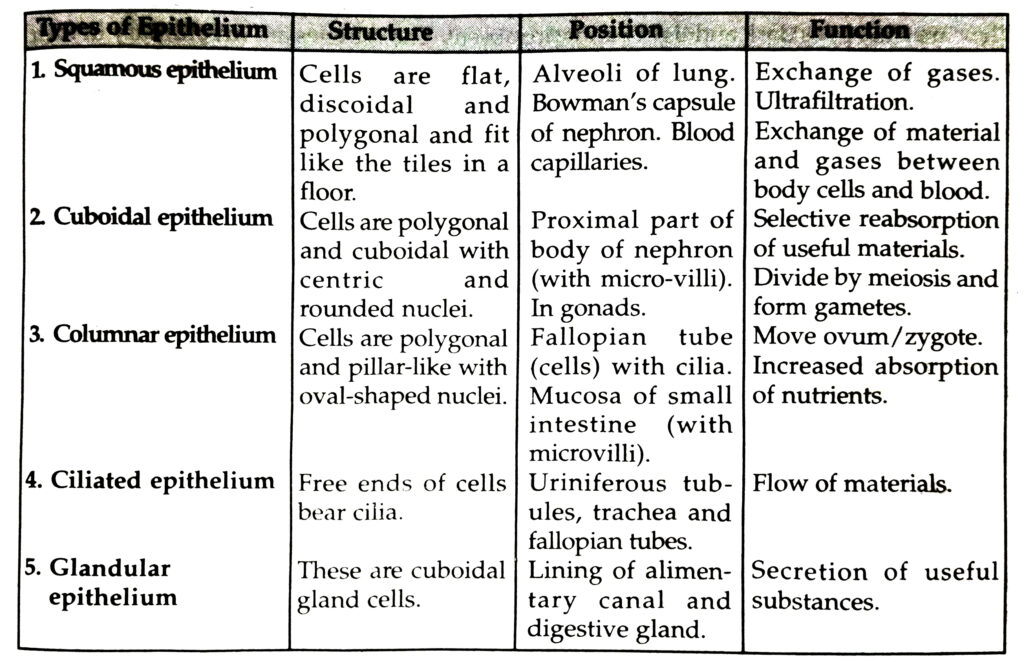
Q. 8. List various forms of connective tissue and write functions of each.
Ans.— Kinds of connective tissue
1. Proper connective tissue. It joins the body parts, such as blood vessels and nerves.
2. Bone. It is the hardest tissue. It forms skeleton and provides shape to body. It protects the body organs.
3. Cartilage. It forms parts of endoskeleton. It forms tip of nose, pinna, ends of long bones.
4. Blood. It is fluid tissue. It transports materials and gases in the body,
5. Tendon. It connects muscles with bone.
6. Ligament. It connects bone with bone.
Q. 9. Draw diagrams showing :
(a) Squamous epithelium (b) Cuboidal epithelium (c) Columnar epithelium
Ans.—

SHORT ANSWER TYPE QUESTIONS
Q. 1. What is tissue? What are its kinds ?
Ans.— Tissue. A tissue is a group of cells having a similar origin alongwith intercellular material and performing a similar function. The different cells of a tissue are usually joined together. The microscopic study of tissues is called histology. the constitution, their structure and arrangement, tissues are of two
Depending upon types simple and complex (= compound).
A simple tissue is made up of only one type of cells while a complex tissue consists of two or more types of cells.
In animals such a distinction is not possible. Here, the tissues that make up the bulk of the animal body are called fundamental tissues.
Q. 2. List two typical features of plant tissues with regard to functions.
Ans.— Features of plant tissue. 1. Supportive which provide them with structural strength. 2. Presence of meristematic tissues localised in certain selected region.
Q. 3. Why are most of tissues of animals are living as compared to plants ?
Ans.— The animals move around in search of food, mates and shelter and consume more energy as compared to plants. Thus they are living.
Q.4. Describe the salient features of meristematic tissue.
Ans.— Characteristic features of meristematic tissue are as follows :
1. They consist of immature cells which are in a state of division and growth.
2. They are compactly arranged so that there are no intercellular spaces in between them.
3. The cells have thin walls.)
4. Each cell consists of a prominent nucleus and dense cytoplasm.
5. Vacuole in the cells is usually absent, if present it is quite small.
Q. 5. What is the role of meristem in plant ?
Ans.— The chief function of meristem is growth of plant, its organs and its body. The cells of meristem undergo cell division which is followed by cell elongation. This results in the growth of plant and differentiation of organs like leaves, buds etc.
Q. 6. What are the kinds of meristem depending upon location ?
Ans.— Depending upon the position (location) in the plant body, the meristems may be apical, intercalary and lateral.
1. Apical meristems are born at the tips of the stems, roots and their branches.
2. Intercalary meristems are the left-out portions of the apical meristems that get separated from the latter by the differentiation of permanent tissues in-between meristems at the base of leaves or internodes.
3. Lateral meristems are located along the lateral sides of stems and roots.
Q. 7. What do you understand by permanent tissue ?
Ans.— Permanent tissue. They are composed of mature cells which after undergoing complete growth have assumed a definite shape, size and function. They have lost the power of division. The permanent tissues are of two types i.e. simple tissue and compound tissue.
Q. 8. Name the different kinds of simple tissue.
Ans.— Kinds of simple tissue
1. Parenchyma
2. Collenchyma
3. Sclerenchyma.
Q. 9. What are the characteristics of parenchyma ? Give two examples of specialized parenchyma cells.
Ans.— Parenchyma. It is the most common type of simple permanent tissue found in almost all the parts of the plant.
Characteristics of parenchyma
1. It is the main representative of the ground tissue system. It forms a continuous soft tissue, as in the cortex and pith of stems, cortex of roots, ground tissue, petiole, mesophyll of leaves.
2. It is thin walled.
3. They retain the ability to divide at maturity.
4. The cells of parenchyma vary in their shape, but a typical ground tissue parenchyma cell is equal in length and Width.
5. Parenchyma of stems and roots stores nutrients and water.

Examples of specialized parenchyma.
1. Chlorenchyma. In some cases the parenchyma cells contain chloroplasts and are called as chlorenchyma. These cells are meant for photosynthesis.
2. Aerenchyma. In aquatic plants parenchyma cells occur around air cavities, they are called as aerenchyma e.g. in Hydrilla stem. Aerenchyma provides buoyancy to the plants to help them float.
Q. 10. Mention any two functions of parenchyma.
Ans.— Functions of parenchyma.
1. It provides rigidity and also stores food in the form of starch, proteins, oil and fats.
2. In hydrophytes they have large air spaces to keep up buoyancy of plants.
Q. 11. Explain the structure and functions of collenchyma.
Ans.— Structure of collenchyma. It is a special type of parenchyma having localised thickenings on the cell walls and is found only in the primary body. The cells are longer than ordinary parenchyma. It is a soft tissue having a pliable primary wall. The thickening of the corners of the cells is due to the addition of cellulose and pectin.
Functions.
1. Provide flexibility as allows easy bending in different parts.
2. It provides rigidity and strenghth.
3. Chloroplast containing collenchyma takes part in photosynthesis.
Q. 12. What is sclerenchyma ? What are its two main kinds ? Give one example.
Ans.— Sclerenchyma. The cells of this t of tissue have very thick cell walls. Most of these cells may be dead. They are long and narrow as walls are thickened due to lignin. They provide mechanical support de m to the plants and parts. Sclerenchyma cells are generally of two types i.e. Fibres and sclereids.

Q. 13. State the location and one function of each of the following tissues: Parenchyma, Sclerenchyma and Collenchyma.
Ans.—
| Name of tissue | Location | Function |
| 1. Parenchyma | Soft parts | Store food |
| 2. Sclerenchyma | Stems and veins | Strength to the plant. |
| 3. Collenchyma | Leaf stalk and below epidermis of leaf. | Support and Photosynthesis. |
Q. 14. What is stomata? Show structure of stomata with the help of figure.
Ans.— Stomata. Small pores present in epidermis of leaf are called stomata. Stomata are enclosed by two kidney-shaped cells called guard cells.
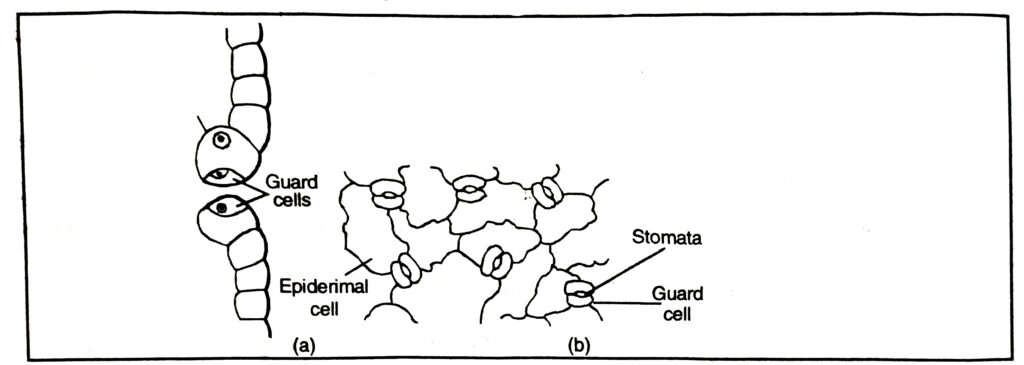
Q. 15. Write functions of stomata.
Or
What are the functions of stomata ?
Ans.— Functions of stomata. 1. Stomata are necessary for exchanging gases with the atmosphere.
2. Transpiration (loss of water in the form of water vapours) also takes place through stomata.
Q. 16. What is xylem ? Write its two main functions.
Ans.— Xylem. It is a permanent, complex sap conducting tissue. It is made of four kinds of
1. Tracheids svie eqism
2. Tracheae or vessels
3. Xylem fibres
4. Xylem parenchyma.
Functions
1. It is mainly responsible for conduction of water and minerals.
2. Provides mechanical strength.
Q. 17. Give a brief account of Phloem.
Ans.— Phloem. It is a complex permanent tissue which conducts organic materials inside the plant. Phloem consists of four types of cells-sieve tubes, companion cells, phloem parenchyma and phloem fibres. Except for phloem fibres, phloem cells are living cells.
Functions
1. Phloem transports food from leaves to other parts.
2. Phloem parenchyma helps in storage of food.
3. Materials can move in both directions.
Q. 18. Differentiate meristematic cells and permanent cells.
Ans.— Differences between meristematic cells and permanent cells
| Meristematic cells | Permanent cells |
| 1. These cells do not have large vacuoles. | 1. These cells often have large central vacuoles. |
| 2. They are thin walled and isodiametric. | 2. They may be thin or thick walled. They have permanent shape. |
| 3. These cells can divide and produce new cells. | 3. These cells have lost the power of growth and cell division. |
Q. 19. Differentiate parenchyma and collenchyma.
Ans.— Differences between parenchyma and collenchyma
| Parenchyma | Collenchyma |
| 1. The cell walls are uniformly thickened. | 1. The cell walls get extra thickened at places. |
| 2. Parenchyma does not have any permanent mechanical function except when its cells are turgid. | 2. It is a living mechanical tissue. |
| 3. Parenchyma is formed both in the outer and inner parts of plant organs. | 3. It is mostly restricted to outer parts of plant organs. |
Q. 20. Compare xylem and phloem.
Ans.— Differences between xylem and phloem
| Xylem | Phloem |
| 1. The conducting cells are vessels. | 1. The conducting cells are phloem sieve tubes. |
| 2. Xylem conducts water and minerals. | 2. Phloem translocates organic food. |
| 3. Xylem lies deeper in plant organs. | 3. Phloem is situated towards outer side. |
| 4. Xylem also provides mechanical strength. | 4. Phloem has no mechanical function. |
| 5. There is one way conduction of materials. | 5. Materials can move in both directions. |
Q. 21. What are different kinds of animal tissues ? Give one example and one function of each type.
Ans.— Types of animal tissues
| Name of tissue | Example | Function |
| Epithelial Tissue | Internal and external surfaces of body and its organs | Protection |
| Connective Tissue | Bone, Cartilage, Areolar tissue, Blood | Connects two similar or different types of tissues together. |
| Muscular Tissue | Body wall, Limbs, Tongue, Face. | Movements and protection. |
| Nervous Tissue | Brain and Spinal cord. | Conduction of messages and co-ordination of various parts of body. |
Q. 22. What is epithelial tissue? Write a note on it.
Ans.— Epithelial Tissue
It is a type of tissue in which the cells are arranged into a single or multilayered sheet with very little intercellular spaces. The individual cells of this tissue are joined to one another by a cementing substance. The cells rest on basement membrane. They do not have any direct blood supply but receive the nourishment from intercellular substance. It is always found forming the outer surfaces of body organs and internal lining of cavities. Epithelial tissue is also called Epithelium. It is of two kinds-Simple epithelium and compound epithelium.
Q. 23. List the functions of epithelial tissues.
Ans.— Functions of epithelial tissue.
1. The epithelium protects the body from micro-organisms, chemicals and evaporation.
2. The epithelium absorbs the materials from external medium.
3. Some of epithelial cells are secretory.
4. They are highly sensitive to external stimuli.
Q. 24. Give an outline classification of epithelial tissue.
Ans.— Outline classification of epithelial tissue

Q. 25. Write the location and function of squamous epithelium.
Ans.— Location and function of squamous epithelium.
1. Lining of alveoli for gaseous exchange.
2. In Bowman’s capsule for ultrafiltration.
3. Lining of blood vessels and coelom.
Q. 26. Write typical features of ciliated epithelium. Give location.
Ans.— Ciliated epithelium. These cells may be columnar or cuboidal and free surfaces bear fine hair like cilia which help in the movement of particular direction.
Location. It is found forming the lining of some hollow organs such as fallopian tubes, bronchioles and small bronchi.
Q. 27. What kind of epithelium lies in each of the following structures and organs :
(i) oesophagus (ii) ileum (iii) pulmonary alveoli (iv) blood vessels (v) epidermis of skin.
Ans.— (i) Oesophagus. Squamous epithelium.
(ii) Ileum. Columnar epithelium.
(iii) Pulmonary alveoli. Squamous epithelium.
(iv) Blood vessels. Squamous epithelium.
(v) Epidermis of skin. Compound, squamous epithelium.
Q. 28. What is connective tissue ? List the different kinds of connective tissue.
Ans.— Connective Tissue
As the name suggests, it connects or binds the similar or different kinds of tissues. Cells are scattered and intercellular space is filled with matrix. Cells of connective tissue characteristically secrete ground substance called matrix. In the matrix are present cells and fibres.
The nature and function of each connective tissue is determined by the nature of the matrix. Connective tissue is of following types :
(a) Proper connective tissue (Jelly-like matrix),
(b) Skeletal (matrix-tough impregnated with salts)-Bone and cartilage.
(c) Vascular tissue (Fluid-matrix) Blood and lymph.
Q. 29. Give broad outline classification of connective tissue.
Ans.— CONNECTIVE TISSUE
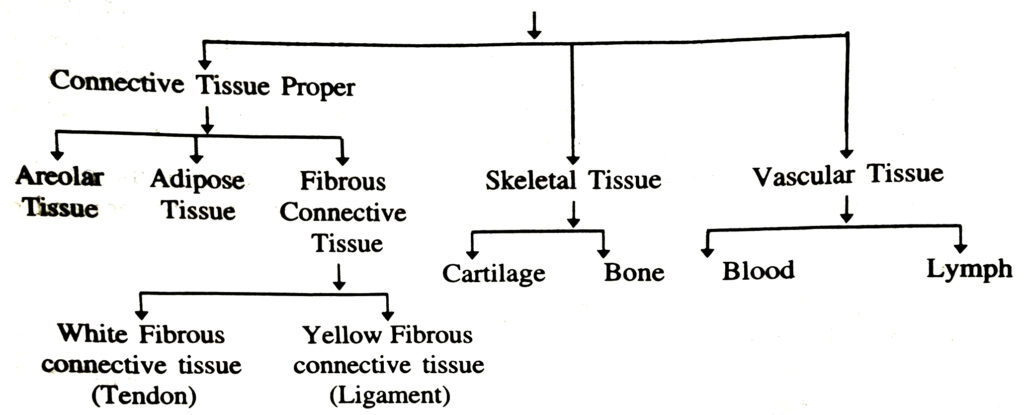
Q. 30. Write a note on areolar tissue. Sketch the type of cells present in it.
Ans.— Areolar tissue. It is a typical connective tissue. It consists of a non-living ground substance called matrix. In the matrix are present cells. The cells are of three types :
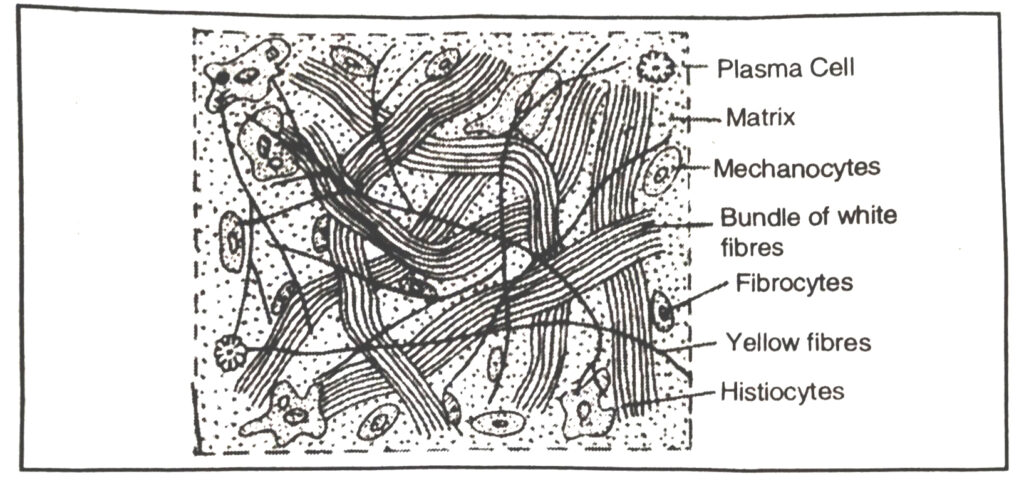
(a) Oval shaped mast cells, they secrete matrix and contain histamine.
(b) Fibroblasts are irregularly shaped flat cells with long protoplasmic processes which form fibres.
(c) Macrophages. They are amoeboid shaped and engulf the foreign particles by phagocytosis.
Q. 31. What is white fibrous connective tissue ? Explain tendon and ligament.
Ans.— White Fibrous Connective Tissue. It is a silvery white connective tissue which contains abundant white fibres. Yellow fibres are rare. The tissue occurs at the joints of skull bones and covering sheaths of bone, cartilage, muscles, etc.
1. Tendon. It is a connective tissue which binds skeletal muscles to the bones. The tissue occurs in small bands. It contains abundant parallel bundles of white fibres with flattened tendon cells of fibroblasts found in rows in between them.
2. Ligament. It is an elastic connective tissue which connects one bone with another. Internally it contains bundles of white fibres running in different directions and scattered yellow fibres. Fibroblasts occur in between the bundles of white fibres.
Q. 32. Give a brief account of nature, occurrence and functions of cartilage.
Ans.— Cartilage.
Nature. It is a non-porous tissue in which the intercellular matrix is abundant, composed of proteins. The matrix is tough and has a delicate network of fibres, and cells called cartilage cells or chondroblasts which completely occupy fluid-filled spaces known as lacunae. Blood vessels are absent in the matrix. As such, the cartilage is surrounded by a layer of dense white fibrous connective tissue called perichondrium through which nutrition reaches the cartilage by diffusion.
Occurrence. Ear pinna, nose tip, epiglottis and intervertebral discs of mammals, end of long bones, lower ends of ribs and sternum, rings of trachea (wind-pipe) and nasal barr septum.
Function
1. Provides support and flexibility to the part.
2. It smoothens loose surface.
Q. 33. Draw T.S. of Cartilage.
Ans.— T.S. of cartilage.
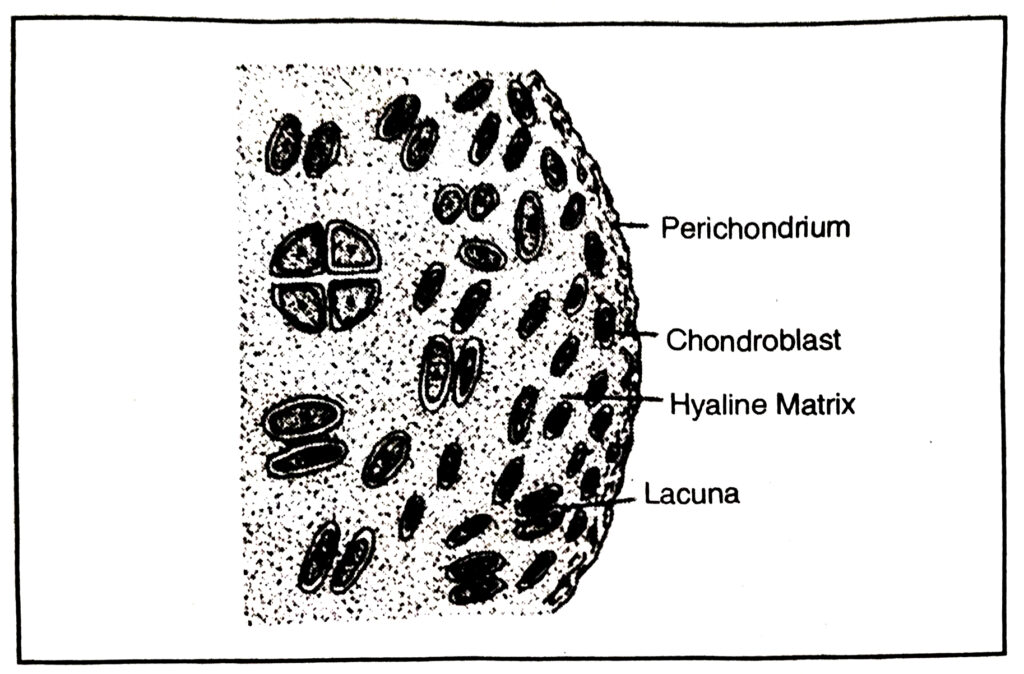
Q. 34. Describe the bone.
Ans.— Bone. The bone is a hard porous tissue. The matrix is impregnated with phosphates and carbonates of calcium and magnesium which accounts for its hardness. The matrix also contains ossein protein. The matrix is arranged in concentric rings called lamellae.
Bone cells (Osteocytes) lie between the lamellae in fluid-filled spaces called lacunae.
Osteoblasts cells produce bone.
Periosteum is a connective tissue surrounding the bone by which muscles and tendons are attached to the bone.
Functions.
1. Bones form the natural skeleton and provides support to the body.
2. Helps in movements.
Q. 35. Draw T.S. of mammalian bone.
Ans.— T.S. of mammalian bone.

Q. 36. List the functions of bone.
Ans.— Functions of bone
1. It forms framework of body.
2. It provides definite shape to the body.
3. It protects the internal organs of body, such as brain, spinal cord, heart and lungs.
4. It provides solid surface for attachment of muscles so that they may act as system of levers in motion and locomotion.
5. Skeleton stores certain mineral reserves.
6. R.B.C.S. are formed in the bone marrow.
Q. 37. Write a note on blood.
Ans.— Blood. It consists of plasma, red blood corpuscles, white blood corpuscles and platelets, circulates in blood vessels. Red corpuscles are circular, biconcave and enucleated in mammals, carry O₂ and CO₂. White corpuscles are nucleated, have granular or nongranular cytoplasm, and defend the body. Platelets help in blood clotting. Plasma transports materials and contains proteins that maintain osmotic pressure, help in blood clotting and act as antibodies.
Q. 38. What is lymph ?
Ans.— Lymph. Colourless fluid tissue consists of plasma and white corpuscles, circulates in lymph vessels. It acts as middle man between blood and tissue.
Q. 39. List functions of RBC.
Ans.— Functions of RBC. 1. They transport O, to tissues from respiratory organs as oxyhaemoglobin.
2. Erythrocytes also participate in transport of CO. Mainly CO₂ is carried as bicarbonate
Q. 40. What is muscular tissue ?
Ans.— Muscular Tissue
The muscular tissue is a contractile tissue consisting of very large cells. Excitability and contractility are properties of protoplasm called sarcoplasm which is very well developed in these tissues. These cells bring about locomotion and movement of internal organs. Based on structural and functional differences, three types of muscles are recognised. They are unstriated, striated and cardiac muscles.
Q. 41. What are the main functions of muscular tissue ? Name the three kinds of muscular tissue.
Ans.— Functions. 1. The muscular tissues help in protection of body.
2. The muscles bring about various kinds of movements.
Types of muscular tissue. The muscular tissue is of three kinds :
1. Unstriated or visceral muscle fibres.
2. Striated or skeletal muscle fibres.
3. Cardiac muscle fibres.
Q. 42. (i) Write the similarities between cardiac muscles and striped muscles.
(ii) Outline two similarities between smooth and cardiac muscles.
Ans.— (i) Similarities of cardiac muscles with striped muscles.
1. Both are striated and bear dark and light bands.
2. Both are cylindrical in shape.
3. Blood supply is abundant.
(ii) Similarities between smooth and cardiac muscles.
1. Nucleus is present centrally in both muscles.
2. Both are involuntary muscles.
Q. 43. Differentiate skeletal and smooth muscles.
Ans.— Differences between skeletal (striped) and smooth muscles (unstriped)
| Skeletal muscles (striped) | Smooth muscles (unstriped) |
| 1. Muscle fibres are cylindrical and unbranched. | 1. Fibres are spindle shaped and unbranched. |
| 2. Multinucleate and nuclei lie in the peripheral region. | 2. Uninucleate and nucleus lies in the middle. |
| 3. Striated due to presence of dark and light bands. | 3. Non-striated. |
Q. 44. Describe the neuron.
Ans.— Nerve Cells (Neurons). May be unipolar, bipolar or multipolar, with one axon and one or more dendrons. Dendrites carry nerve impulses towards the cell body and axon away from it. Cell body has Nissl’s granules in the cytoplasm. Axons form synapses with the dendrites and cell body or axon of some other neuron.
Q. 45. What is nerve fibre ? Name the two main types.
Ans.— Nerve Fibres. These are extended axons or dendrites. There are two types :
1. Medullated Nerve Fibres. These have thick myelin sheath, occur in white matter of brain and spinal cord and in cranial and spinal nerves.
2. Non-medullated Nerve Fibres. These have very thin myelin sheath, occur in sympathetic nerves.
Q. 46. Differentiate tendon and ligament.
Ans.— Differences between Tendon and Ligament
| Tendon | Ligament |
| 1. It is an inelastic band. | 1. It is an elastic band. |
| 2. Tendon connects a muscle with a bone. | 2. Ligament connects one bone with another bone. |
| 3. Yellow fibres are absent. | 3. Yellow fibres are present. |
| 4. Bundle of white fibres occur in parallel series. | 4. Bundles of white fibres run in different directions. |
Q. 47. Bring out two points of differences between Bone and Cartilage.
Ans.— Differences between Bone and Cartilage
| Cartilage | Bone |
| 1. It is a soft. Perichondrium covers the cartilage externally. | 1. It is hard. It is covered by periosteum. |
| 2. Matrix is not arranged in lamellae. | 2. Matrix is arranged in concentric layers called lamellae. |
| 3. Marrow cavity and Bone marrow absent. | 3. In the centre of bone, marrow cavity is present. Marrow cavity is filled with bone marrow. |
VERY SHORT ANSWER TYPE QUESTIONS
Q. 1. Define tissue. Name two types of plant tissues.
Ans.— Tissue is a group of similar or dissimilar cells coordinating to perform a specific function so as to give highest possible efficiency.
Two types of plant tissues are : Meristematic and Permanent tissue.
Q. 2. Name three types of meristematic tissues.
Ans.— 1. Apical meristem 2. Intercalary meristem 3. Lateral meristem.
Q. 3. How is permanent tissue formed from meristematic tissue ?
Ans.— Cells take up specific role and lose ability to divide, it is termed differentiation.
Q. 4. What is the advantage of dead cell in plants ?
Ans.— Dead cells in plants provide structural strength and need less maintenance.
Q. 5. What is the function of parenchyma ?
Ans.— Storage of food, photosynthesis, and short distance conduction.
Q. 6. Give the function of collenchyma.
Ans.— Mechanical support and may become photosynthetic.
Q. 7. What is function of sclerenchyma ?
Ans.— Sclerenchyma is chief mechanical supporting tissue.
Q. 8. Which tissue is responsible for conduction of food in plants ?
Ans.— Phloem.
Q. 9. Write function of xylem.
Ans.— Conduction of water and minerals.
Q. 10. Name the peripheral and water proof dead tissue of old stem of woody trees.
Ans.— Cork.
Q. 11. What are stomata ?
Ans.— Small pores in the epidermis of leaf.
Q. 12. What are guard cells ?
Ans.— Stomata are enclosed by two kidney-shaped guard cell.
Q. 13. List two functions of stomata.
Ans.— (i) Transpiration and (ii) Exchange of gases.
Q. 14. Which type of tissue is located in the lung alveoli and why ?
Ans.— Squamous epithelium. It allows exchange of O2 of air and CO₂ of blood.
Q. 15. Give the location and function of cuboidal epithelium.
Ans.— In the germinal epithelium of gonads (testes and ovaries). Cells divide by meiosis to form gametes (sperms and ova).
Q. 16. Why are the smooth muscle fibres called visceral muscle fibres ?
Ans.— These are present in layers in the wall of visceral organs of body.
Q. 17. Why are the striated muscle fibres called voluntary muscle fibres ?
Ans.— Because these are under the will of an animal.
Q. 18. What are functions of RBCs ?
Ans.— 1. Transportation of oxygen as well as carbon dioxide.
2. pH constancy as haemoglobin acts as a buffer protein.
Q. 19. Give the function of lymph.
Ans.— Lymph acts as middle man so helps in exchange of materials between blood and body cells.
Q. 20. Name the structural and functional units of nervous tissue.
Ans.— Neurons.
Q. 21. How is a nerve formed ?
Ans.— Many nerve fibres bound together by connective tissue.
Q. 22. Name the two types of nerve processes of a neuron.
Ans.— Dendrites and Axon.
MULTIPLE CHOICE QUESTIONS
Select the Correct Answer :
1. Collenchyma is found in :
(A) Herbaceous monocots
(B) Herbaceous dicots
(C) All herbaceous plants
(D) Pteridophytes and monocots.
Ans.— (B) Herbaceous dicots
2. Sieve tube cell is :
(A) multinucleated
(B) dead cell
(C) enucleated
(D) nucleated.
Ans.— (C) enucleated
3. The middle lamella of cells is made of :
(A) Pepsin
(B) Pectin
(C) Protein
(D) Starch.
Ans.— (B) Pectin
4. A tracheid is distinguish from a vessel element on the basis of :
(A) Length
(B) Thickness
(C) Side-wall thickening
(D) End-wall perforations.
Ans.— (D) End-wall perforations.
5. Vessels and companion cells are the characteristic features of :
(A) Gymnosperms
(B) Angiosperms
(C) Pteridophytes
(D) Fungi.
Ans.— (B) Angiosperms
6. In connective tissues, the matrix may have
(A) liquid consistency
(B) jelly like consistency
(C) semi solid consistency
(D) all of these.
Ans.— (D) all of these.
7. In cuboidal epithelial cells the nuclei are situated :
(A) centrally
(B) apically
(C) basally
(D) eccentrically.
Ans.— (A) centrally
8. Brush border is characteristic of :
(A) secretory cells
(B) absorptive cells
(C) osteocytes
(D) never cells.
Ans.— (B) absorptive cells
9. Matrix of areolar tissue is secreted by :
(A) Fibroblasts
(B) Histiocytes
(C) Mast cells
(D) None of these.
Ans.— (C) Mast cells
10. The basis for the classification of various types of connective tissue is its :
(A) function
(B) structure
(C) location and function
(D) intercellular material.
Ans.— (D) intercellular material.
11. Primary tissues of a plant :
(A) add to the length of roots and shoots
(B) add to the diameter of existing roots and shoots
(C) are only in the embryo
(D) are only in the seedling.
Ans.— (A) add to the length of roots and shoots
12. Group of cells with same origin and function is :
(A) organ
(B) simple tissue
(C) any tissue
(D) compound tissue.
Ans.— (B) simple tissue
13. Lignified elongated dead cells are :
(A) parenchyma
(B) collenchyma
(C) sclerenchyma
(D) None of above.
Ans.— (C) sclerenchyma
14. The phloem in the plants does the function of :
(A) providing support
(B) mineral movement
(C) conduction of food
(D) conduction of water.
Ans.— (C) conduction of food
15. Collenchyma differs from sclerenchyma in :
(A) retaining protoplasm at maturity
(B) having thick walls
(C) having inside lumen
(D) being dead.
Ans.— (A) retaining protoplasm at maturity
16. The chief function of parenchymatous
(A) synthesize food
(B) store food materials
(C) absorb moisture
(D) conduct food materials.
Ans.— (B) store food materials
17. Blood is a :
(A) Muscular tissue
(B) Connective tissue
(C) Epithelial tissue
(D) Nervous tissue.
Ans.— (B) Connective tissue
Follow on Facebook page – Click Here
Google News join in – Click Here
Read More Asia News – Click Here
Read More Sports News – Click Here
Read More Crypto News – Click Here